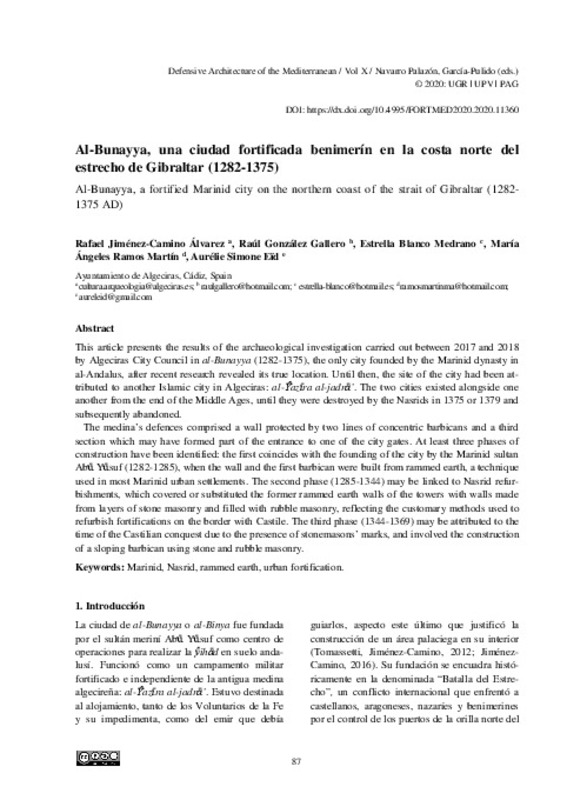JavaScript is disabled for your browser. Some features of this site may not work without it.
Buscar en RiuNet
Listar
Mi cuenta
Estadísticas
Ayuda RiuNet
Admin. UPV
Al-Bunayya, una ciudad fortificada benimerín en la costa norte del estrecho de Gibraltar (1282-1375)
Mostrar el registro sencillo del ítem
Ficheros en el ítem
| dc.contributor.author | Jiménez-Camino Álvarez, Rafael
|
es_ES |
| dc.contributor.author | González Gallero, Raúl
|
es_ES |
| dc.contributor.author | Blanco Medrano, Estrella
|
es_ES |
| dc.contributor.author | Ramos Martín, María Ángeles
|
es_ES |
| dc.contributor.author | Eïd, Aurélie Simone
|
es_ES |
| dc.coverage.spatial | east=-5.456233000000001; north=36.1407591; name=11204 Algeciras, Cádiz, Espanya | es_ES |
| dc.date.accessioned | 2020-07-15T10:34:17Z | |
| dc.date.available | 2020-07-15T10:34:17Z | |
| dc.date.issued | 2020-05-15 | |
| dc.identifier.isbn | 9788490488560 | |
| dc.identifier.uri | http://hdl.handle.net/10251/148046 | |
| dc.description.abstract | [EN] This article presents the results of the archaeological investigation carried out between 2017 and 2018 by Algeciras City Council in al-Bunayya (1282-1375), the only city founded by the Marinid dynasty in al-Andalus, after recent research revealed its true location. Until then, the site of the city had been attributed to another Islamic city in Algeciras: al-Ŷazīra al-jadrā’. The two cities existed alongside one another from the end of the Middle Ages, until they were destroyed by the Nasrids in 1375 or 1379 and subsequently abandoned. The medina’s defences comprised a wall protected by two lines of concentric barbicans and a third section which may have formed part of the entrance to one of the city gates. At least three phases of construction have been identified: the first coincides with the founding of the city by the Marinid sultan Abū Yūsuf (1282-1285), when the wall and the first barbican were built from rammed earth, a technique used in most Marinid urban settlements. The second phase (1285-1344) may be linked to Nasrid refurbishments, which covered or substituted the former rammed earth walls of the towers with walls made from layers of stone masonry and filled with rubble masonry, reflecting the customary methods used to refurbish fortifications on the border with Castile. The third phase (1344-1369) may be attributed to the time of the Castilian conquest due to the presence of stonemasons’ marks, and involved the construction of a sloping barbican using stone and rubble masonry. | es_ES |
| dc.language | Español | es_ES |
| dc.publisher | Editorial Universitat Politècnica de València | es_ES |
| dc.rights | Reconocimiento - No comercial - Sin obra derivada (by-nc-nd) | es_ES |
| dc.subject | Fortifications | es_ES |
| dc.subject | Mediterranean | es_ES |
| dc.subject | Modern age | es_ES |
| dc.subject | Built Heritage | es_ES |
| dc.subject | Marinid | es_ES |
| dc.subject | Nasrid | es_ES |
| dc.subject | Rammed earth | es_ES |
| dc.subject | Urban fortification | es_ES |
| dc.title | Al-Bunayya, una ciudad fortificada benimerín en la costa norte del estrecho de Gibraltar (1282-1375) | es_ES |
| dc.title.alternative | Al-Bunayya, a fortified Marinid city on the northern coast of the strait of Gibraltar (1282- 1375 AD) | es_ES |
| dc.type | Capítulo de libro | es_ES |
| dc.type | Comunicación en congreso | es_ES |
| dc.identifier.doi | 10.4995/FORTMED2020.2020.11360 | |
| dc.rights.accessRights | Abierto | es_ES |
| dc.description.bibliographicCitation | Jiménez-Camino Álvarez, R.; González Gallero, R.; Blanco Medrano, E.; Ramos Martín, MÁ.; Eïd, AS. (2020). Al-Bunayya, una ciudad fortificada benimerín en la costa norte del estrecho de Gibraltar (1282-1375). Editorial Universitat Politècnica de València. 87-94. https://doi.org/10.4995/FORTMED2020.2020.11360 | es_ES |
| dc.description.accrualMethod | OCS | es_ES |
| dc.relation.conferencename | FORTMED2020 - Defensive Architecture of the Mediterranean | es_ES |
| dc.relation.conferencedate | Octubre 01-03,2020 | es_ES |
| dc.relation.conferenceplace | Granada, Spain | es_ES |
| dc.relation.publisherversion | http://ocs.editorial.upv.es/index.php/FORTMED/FORTMED2020/paper/view/11360 | es_ES |
| dc.description.upvformatpinicio | 87 | es_ES |
| dc.description.upvformatpfin | 94 | es_ES |
| dc.type.version | info:eu-repo/semantics/publishedVersion | es_ES |
| dc.relation.pasarela | OCS\11360 | es_ES |








